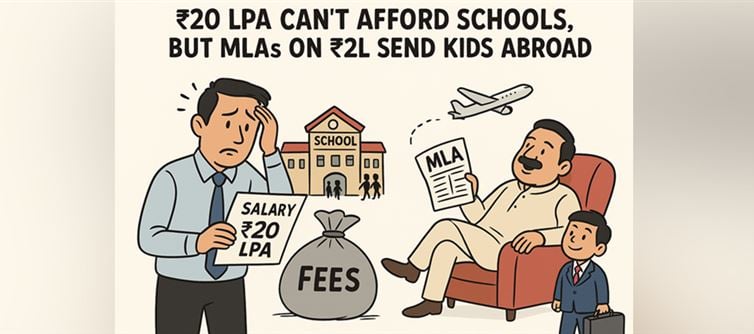
In India’s metro cities, a mid-level corporate employee earning ₹20 lakh per year (about ₹1.6 lakh/month) finds it nearly impossible to afford private school fees for their children—fees that now range from ₹2.5 lakh to ₹11 lakh per year.
Yet, our MLAs, whose official salaries range between ₹70,000 to ₹2.5 lakh per month, somehow manage not just to send their children to elite private schools but often to foreign universities as well. The math doesn’t add up—unless, of course, we factor in the “hidden income streams” of politics. Here’s the breakdown:
1. Corporate Employee: High Pay, Higher Struggle
₹20 LPA looks big on paper, but after tax, EMIs, rent, and cost of living in metros, savings shrink.
Private school education feels like a luxury even for the so-called “upper middle class.”
2. MLA Salary vs mla lifestyle – A Mismatch
With salaries between ₹70k–₹2.5L per month, MLAs officially make less than many corporate professionals.
Yet their children study abroad, their families own luxury cars, and their lifestyle rivals CEOs.
3. The “Other Income” Nobody Talks About
Power in politics often brings access to contracts, commissions, and cut money.
While corporates slog 12-hour shifts for bonuses, MLAs enjoy “side incomes” that are conveniently invisible on paper.
4. Public Service, Private Privilege
MLAs call themselves “public servants,” but their lifestyles scream private privilege.
The same politicians who oppose fee regulation in private schools happily pay (or rather, afford) lakhs in fees abroad.
5. The Real Eye-Opener
If corporate India is struggling with ₹20 LPA, how exactly do MLAs sustain foreign education, luxury homes, and extravagant lifestyles on their declared income?
The answer points straight to corruption, misuse of power, and money that never shows up on salary slips.
🔥 The Bottomline: India’s middle class pays taxes, tightens budgets, and sacrifices dreams, while MLAs with “modest” salaries live like millionaires. It’s not just a mismatch—it’s an exposé of how politics bankrolls privilege while the taxpayer foots the bill.




 click and follow Indiaherald WhatsApp channel
click and follow Indiaherald WhatsApp channel